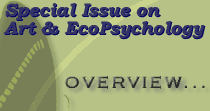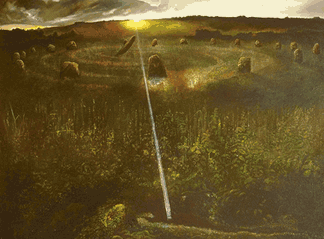

 |
 |
 |
 |
 |
|
EcoPsychology
and Art
by Amy Lenzo |
|
'Boscawen'
© by Christopher Castle |
|
"Art
is our oldest and richest form of environmental awareness. The
earliest artistic expressions we know (the great Paleolithic cave
paintings and Neolithic ceremonial sites) are celebrations of
natural wonder. Long
before science, art and religion were viewed as separate realms,
these works constellated the keenest knowledge our ancestors possessed
of the heavens and the Earth".
Once
upon a time in human history, ‘art’ was so much a part
of the human experience that there wasn’t even a word to
differentiate it as a separate sphere of activity. Whatever our
race or ethnicity, we can each trace our origins to this early
period, when cultures over the entire geographic spectrum held
several elements in common. Food, eating utensils, clothing, shelter,
ceremonial objects – everything we needed to live- was fashioned
by hand, made from materials bountiful within our environment.
The human spirit has always recognized the sacred, and our original
culture valued and utilized the ability to interpret reality and
communicate our understandings to each other via ritual and symbol.
Our lives were led in accordance with natural principles, and
reflected an immediate relationship with the natural world. I
start with this fairy tale beginning, not to unfavorably compare
our modern lives with some impossible lost paradise, but to point
out the intertwined roots of these two complex and multi-dimensional
words: ‘art’ and ‘ecopsychology’, in order
to find where their current relevance to each other might be.
Although
we all still live within the natural world, most of us have traveled
far from the place where we recognize our relationship with it.
There are indigenous peoples all over the world, however, that
still operate from our original, natural ecopsychological perspective
when they create the ‘indigenous arts’ which are practical
and beautiful elements of their lives. A rug, blanket, basket;
a piece of jewelry, or a map; a mask, or other ceremonial or healing
piece- these pieces start as integral components of life within
a specific culture and often end up being sold in galleries, within
other contexts, in other cultures. But when they were first created,
each of them connected their maker, and those who used them, to
the matrix of beauty and sustenance found naturally in the world
around us. In addition to this direct practical relationship with art, in all historical periods there has also been art that has sustained and nurtured humanity on a psychic level. Much of this art, too, has been derived from (or enhanced by) our relationship with the natural world. Editor Donna Seaman, in her introduction to the new anthology of fiction, In our Nature: Stories of Wildness, recognizes this when she says:
Both
Art and Ecopsychology are concerned with attention, with perception
and imagination, and they share a common language- the language
of the senses. In the making of art, and the experiencing of it—whether
one is viewing, reading, feeling, tasting, listening to, or empathetically
‘connecting with’—we are fine-tuning the sensual
media we are all born with. Art is an innate and natural human
activity. In
many cultures today, art is seen as the product of a rare commodity,
talent, which is parceled out to ‘special’ people under
‘special’ conditions. Either that, or it is depicted
as a fool’s pursuit. But the truth is that art is our birthright.
Our lives are art, or could be, and every aspect of our
experience opens itself to the clarity and beauty that comes with
focusing our attention, our creative energy and imagination, upon
it. Art
is the expression of a powerful and primal force, capable of creating
real effect in our psyches and within the world. Although not
all art is aligned with an ecopsychological view of life, This
issue is a celebration and exploration of art that focuses and
deepens awareness of our connection with ourselves and/or the
rest of the natural world. Whether it uses nature as inspiration
or subject, consciously uses natural materials for its medium,
or ‘paints’ upon it like a canvas, this kind of art
can bring us into direct relationship with ourselves-in-nature.
There
is enormous value in the visual, literary, dramatic and musical
arts, but there are other, gentler, arts, too, equally nurturing
to our spirit and aligned with a nature-based psychology. Gardening
and bee-keeping; potting, weaving, quilting, and knitting; the
culinary, healing and martial arts– all find their roots
in the relationship between the human psyche and the natural world.
They all require sensitivity, and attention, and they all work
with imagination. Sensitivity,
attention and imagination are key elements for both Eco- Psychology
and Art. Laura Sewell talks about the importance of each in her
wonderful book, Sight and Sensibility: The Ecopsychology of
Perception. In it, she cites David Orr’s belief that
there are two obstacles to fully experiencing our lives: one is
denial, manifested by a lack of sensitivity or a numbness, and
the other is lack of imagination. Cultivating
sensitivity, developing our imagination and teaching ourselves
to be aware of our perceptions, honing our senses ever more acutely
and becoming more and more conscious of the process; this is the
artist’s path. The creative process emerges from a heightened
perception—a sensitivity—that is then transformed through
the artist’s process of thought and imagination, and manifested
into being through his or her body and its senses. This depth
of sensitivity is not just the province of artists, either; we
are all born with it. These are the faculties with which we go
out to meet the world, and know our place within it. Sewell and others suggest that the loss of our innate sensitivity to life is a response to, or defense against, the clamor of a culture that, quite literally, goes against our nature. To break through our numbness, into a life that is more fulfilling and connected, may be difficult, but it is deeply fulfilling, and essential. As Sewell says,
Developing our imaginal capacity is no less crucial to this project. We need functioning imaginations in order to envision a different, more connected way of living. Our imaginations help us bridge the gaps between the multiple dimensions of our lives, to link our interior and exterior worlds. It enables us to make whole pictures out of apparent fragments and dualities, and begin to heal the wounds made of our incomplete understandings. These qualities - attention, perception, imagination - are all natural extensions of our senses, and their development is the key to seeding and cultivating a healthy ecopsychology. Reading
List: David
Abram, The Spell of the Sensuous: Perception and Language in
a More-than-Human World, Vintage (1996) Diane
Ackerman, A Natural History of the Senses, Phoenix (1996) Suzi
Gablik, The Re-enchantment of Art, Thames and Hudson (1992) Lucy
Lippard, The Lure of the Local: Senses of Place in a Multicentered
Society, The New Press (1997) Lucy
Lippard, Overlay: Contemporary Art and the Art of Prehistory,
The New Press, New York (1983) T.C.
McLuhan, The Way of the Earth, Touchstone Books (1995) Laura Sewell, Sight and Sensibility: The Ecopsychology of Perception, Tarcher and Putnam (1999)
|
